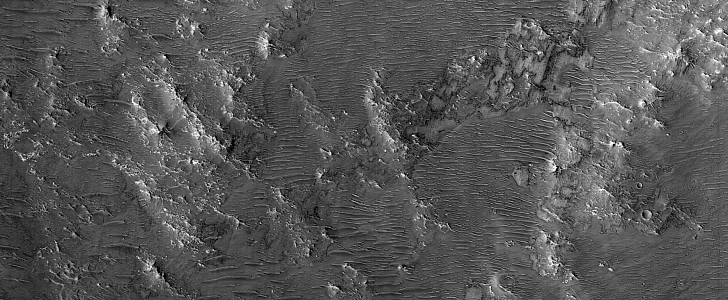Picking a place on Mars for hardware to land is a thing space agencies take very seriously. Just as a properly-built machine could mean the difference between the success of the mission and its failure, so does the landing site.
At the time of writing, of the five robotic vehicles sent over the years to Mars by NASA, just two are still up and running: the Curiosity, and the Perseverance that landed there last year.
The former is located in Gale Crater, while the latter conducts its business in the Jezero Crater. Both reached their destinations after scientists carefully looked at the available options, and discarded most of them.
For Curiosity, the landing site selection process ended after five years of hard work, during which time about 100 possible locations were reviewed. The Mars Reconnaissance Orbiter, home of the HiRISE camera, was instrumental to NASA selecting Gale over the others.
The main photo of this piece shows a place called Eberswalde Crater. It was one of the 100 locations initially selected, and managed to enter the top four before the space agency finally settled to land the rover elsewhere, back in 2011. Later, it would also be on the list of potential landing sites for Perseverance,
It is from 2011 the photo dates, and it was recently brought back into focus by NASA’s as it pushes to really get us on board with future plans for Mars. It shows a portion of the Eberswalde as the HiRISE camera saw it from an altitude of 260 km (161 miles).
Now, the place might look quite unsuitable to land something, given its rough surface, but NASA says “the successful use of the skycrane method, both for Curiosity and the Perseverance rover, show that robotic explorers can land on and adjust to challenging surfaces for exploration.”
The Eberswalde is a buried impact crater 65 km in diameter (40 miles), and was considered as worthy for study as it shows evidence flowing water was once present there.
The former is located in Gale Crater, while the latter conducts its business in the Jezero Crater. Both reached their destinations after scientists carefully looked at the available options, and discarded most of them.
For Curiosity, the landing site selection process ended after five years of hard work, during which time about 100 possible locations were reviewed. The Mars Reconnaissance Orbiter, home of the HiRISE camera, was instrumental to NASA selecting Gale over the others.
The main photo of this piece shows a place called Eberswalde Crater. It was one of the 100 locations initially selected, and managed to enter the top four before the space agency finally settled to land the rover elsewhere, back in 2011. Later, it would also be on the list of potential landing sites for Perseverance,
It is from 2011 the photo dates, and it was recently brought back into focus by NASA’s as it pushes to really get us on board with future plans for Mars. It shows a portion of the Eberswalde as the HiRISE camera saw it from an altitude of 260 km (161 miles).
Now, the place might look quite unsuitable to land something, given its rough surface, but NASA says “the successful use of the skycrane method, both for Curiosity and the Perseverance rover, show that robotic explorers can land on and adjust to challenging surfaces for exploration.”
The Eberswalde is a buried impact crater 65 km in diameter (40 miles), and was considered as worthy for study as it shows evidence flowing water was once present there.






